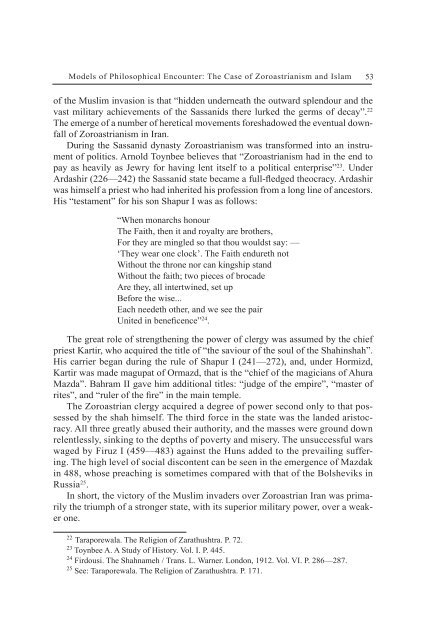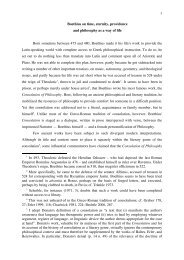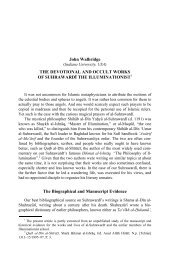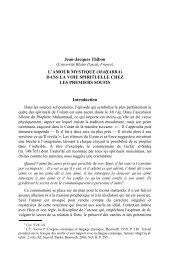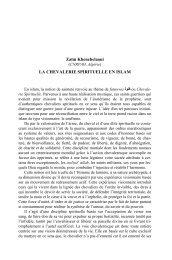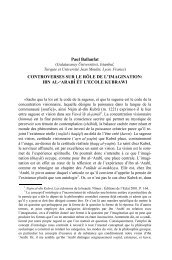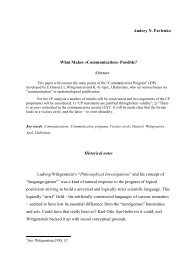Marietta Stepanyants (Institute of Philosophy, Russian Academy of ...
Marietta Stepanyants (Institute of Philosophy, Russian Academy of ...
Marietta Stepanyants (Institute of Philosophy, Russian Academy of ...
You also want an ePaper? Increase the reach of your titles
YUMPU automatically turns print PDFs into web optimized ePapers that Google loves.
Models <strong>of</strong> Philosophical Encounter: The Case <strong>of</strong> Zoroastrianism and Islam 53<br />
<strong>of</strong> the Muslim invasion is that “hidden underneath the outward splendour and the<br />
vast military achievements <strong>of</strong> the Sassanids there lurked the germs <strong>of</strong> decay”. 22<br />
The emerge <strong>of</strong> a number <strong>of</strong> heretical movements foreshadowed the eventual downfall<br />
<strong>of</strong> Zoroastrianism in Iran.<br />
During the Sassanid dynasty Zoroastrianism was transformed into an instrument<br />
<strong>of</strong> politics. Arnold Toynbee believes that “Zoroastrianism had in the end to<br />
pay as heavily as Jewry for having lent itself to a political enterprise” 23 . Under<br />
Ardashir (226—242) the Sassanid state became a full-fledged theocracy. Ardashir<br />
was himself a priest who had inherited his pr<strong>of</strong>ession from a long line <strong>of</strong> ancestors.<br />
His “testament” for his son Shapur I was as follows:<br />
“When monarchs honour<br />
The Faith, then it and royalty are brothers,<br />
For they are mingled so that thou wouldst say: —<br />
‘They wear one clock’. The Faith endureth not<br />
Without the throne nor can kingship stand<br />
Without the faith; two pieces <strong>of</strong> brocade<br />
Are they, all intertwined, set up<br />
Before the wise...<br />
Each needeth other, and we see the pair<br />
United in beneficence” 24 .<br />
The great role <strong>of</strong> strengthening the power <strong>of</strong> clergy was assumed by the chief<br />
priest Kartir, who acquired the title <strong>of</strong> “the saviour <strong>of</strong> the soul <strong>of</strong> the Shahinshah”.<br />
His carrier began during the rule <strong>of</strong> Shapur I (241—272), and, under Hormizd,<br />
Kartir was made magupat <strong>of</strong> Ormazd, that is the “chief <strong>of</strong> the magicians <strong>of</strong> Ahura<br />
Mazda”. Bahram II gave him additional titles: “judge <strong>of</strong> the empire”, “master <strong>of</strong><br />
rites”, and “ruler <strong>of</strong> the fire” in the main temple.<br />
The Zoroastrian clergy acquired a degree <strong>of</strong> power second only to that possessed<br />
by the shah himself. The third force in the state was the landed aristocracy.<br />
All three greatly abused their authority, and the masses were ground down<br />
relentlessly, sinking to the depths <strong>of</strong> poverty and misery. The unsuccessful wars<br />
waged by Firuz I (459—483) against the Huns added to the prevailing suffering.<br />
The high level <strong>of</strong> social discontent can be seen in the emergence <strong>of</strong> Mazdak<br />
in 488, whose preaching is sometimes compared with that <strong>of</strong> the Bolsheviks in<br />
Russia 25 .<br />
In short, the victory <strong>of</strong> the Muslim invaders over Zoroastrian Iran was primarily<br />
the triumph <strong>of</strong> a stronger state, with its superior military power, over a weaker<br />
one.<br />
22 Taraporewala. The Religion <strong>of</strong> Zarathushtra. P. 72.<br />
23 Toynbee A. A Study <strong>of</strong> History. Vol. I. P. 445.<br />
24 Firdousi. The Shahnameh / Trans. L. Warner. London, 1912. Vol. VI. P. 286—287.<br />
25 See: Taraporewala. The Religion <strong>of</strong> Zarathushtra. P. 171.


